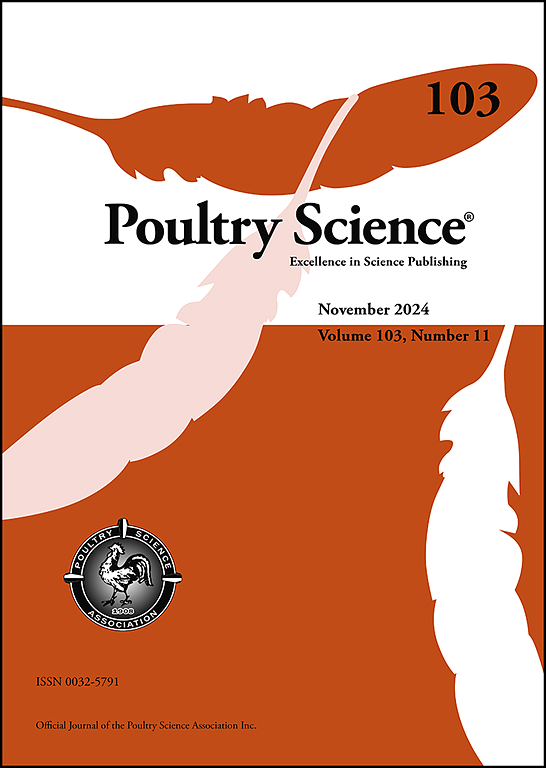Effects of purple corn anthocyanin on slaughter performance, immune function, the caecal microbiota and the transcriptome in chickens
IF 3.8
1区 农林科学
Q1 AGRICULTURE, DAIRY & ANIMAL SCIENCE
引用次数: 0
Abstract
Poultry are susceptible to oxidative stress, which decreases immune function and negatively affects production performance under highly intensive feeding conditions. Moreover, anthocyanins can alleviate oxidative stress and improve immune functions in chickens. This study aimed to elucidate the effects of purple corn anthocyanin extract (PCE) on slaughter performance, immune function, the caecal microbiota and the transcriptome in chickens. A total of 180 female chickens were randomly divided into two groups, with one receiving a basal diet (CON) and one receiving a treatment (PCE) supplemented with 360 mg/kg PCE according to a completely randomized design. The results indicated that the levels of plasma immunoglobulin A, immunoglobulin G, immunoglobulin M, complement 3, and complement 4 in the PCE treatment group were greater (P < 0.05) than those in the CON group. The slaughter performance and caecal short-chain fatty acid parameters did not differ (P > 0.05) between the PCE and CON groups. The inclusion of PCE significantly increased (P < 0.05) the bursa of Fabricius/live weight value compared with those of the CON. Chickens receiving PCE had significantly (P < 0.05) increased relative abundances of norank_f_Muribaculaceae, Anaerofilum, Shuttleworthia, Brachyspira, and Tuzzerella but significantly decreased (P < 0.05) relative abundances of unclassified_f__Rikenellaceae, Oscillospira, norank_f__Barnesiellaceae, norank_f__Christensenellaceae, and Candidatus_Soleaferrea. A total of 2,846 differentially expressed genes (DEGs; P < 0.05), which consisted of 1,140 upregulated genes and 1,706 downregulated genes, were identified. Among them, 201 genes were annotated to the Gene Ontology and Kyoto Encyclopedia of Genes and Genomes database for immune-related genes. Protein-protein interaction network analysis revealed that DEGs associated with the joining chain of multimeric IgA and IgM were significantly upregulated immune-related genes, and those associated with forkhead box P1, cathelicidin 1, cathelicidin 2, and cathelicidin 3 were significantly downregulated immune-related genes in chickens. The findings demonstrated that dietary supplementation with PCE has the potential to improve plasma immunoglobulin, immune organ, caecal potentially beneficial bacteria levels and immune-related gene expressions, which can increase the immune function of chickens.
求助全文
约1分钟内获得全文
求助全文
来源期刊

Poultry Science
农林科学-奶制品与动物科学
CiteScore
7.60
自引率
15.90%
发文量
0
审稿时长
94 days
期刊介绍:
First self-published in 1921, Poultry Science is an internationally renowned monthly journal, known as the authoritative source for a broad range of poultry information and high-caliber research. The journal plays a pivotal role in the dissemination of preeminent poultry-related knowledge across all disciplines. As of January 2020, Poultry Science will become an Open Access journal with no subscription charges, meaning authors who publish here can make their research immediately, permanently, and freely accessible worldwide while retaining copyright to their work. Papers submitted for publication after October 1, 2019 will be published as Open Access papers.
An international journal, Poultry Science publishes original papers, research notes, symposium papers, and reviews of basic science as applied to poultry. This authoritative source of poultry information is consistently ranked by ISI Impact Factor as one of the top 10 agriculture, dairy and animal science journals to deliver high-caliber research. Currently it is the highest-ranked (by Impact Factor and Eigenfactor) journal dedicated to publishing poultry research. Subject areas include breeding, genetics, education, production, management, environment, health, behavior, welfare, immunology, molecular biology, metabolism, nutrition, physiology, reproduction, processing, and products.
 求助内容:
求助内容: 应助结果提醒方式:
应助结果提醒方式:


